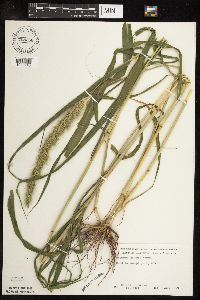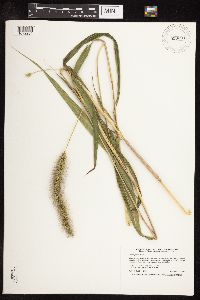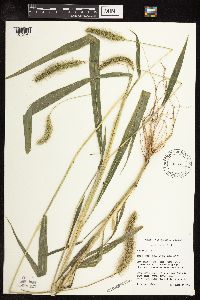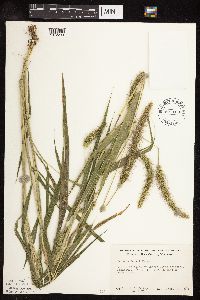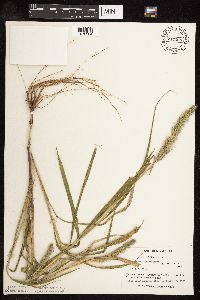Setaria faberi
|
|
|
|
Family: Poaceae
Japanese Bristle Grass, more...Japanese bristlegrass, Chinese foxtail, Chinese millet, giant bristlegrass, giant foxtail, nodding foxtail, tall green bristlegrass, Sétaire Géante
[Setaria autumnalis Ohwi] |
Plants annual. Culms 50-200 cm. Sheaths glabrous, fringed with white hairs; ligules about 2 mm; blades 15-30 cm long, 10-20 mm wide, usually with soft hairs on the adaxial surface. Panicles 6-20 cm, densely spicate, arching and drooping from near the base; rachises densely villous; bristles (1)3(6), about 10 mm. Spikelets 2.5-3 mm. Lower glumes about 1 mm, acute, 3-veined; upper glumes about 2.2 mm, obtuse, 5-veined; lower lemmas about 2.8 mm, obtuse; lower paleas about 2/3 as long as the lower lemmas; upper lemmas pale, finely and distinctly transversely rugose; upper paleas similar to the upper lemmas. 2n = 36. Setaria faberi spread rapidly throughout the North American corn belt after being accidentally introduced from China in the 1920s. It has become a major nuisance in corn and bean fields of the midwestern United States. Annual herb, tufted 0.5 - 2 m tall Leaves: alternate, two-ranked. Sheaths fringed with whitish hairs. Ligules about 2 mm long, membranous, marginally fringed with hairs. Blades 15 - 30 cm long, 1 - 2 cm wide, lance-shaped, softly hairy above, parallel-veined. Inflorescence: a terminal arrangement of spikelets (panicle), dense, arching and nodding, 6 - 20 cm long, spike-like, with numerous bristles about 1 cm long. Axis densely hairy. Fruit: a caryopsis, indehiscent, enclosed within the persistent lemma and palea, ellipsoid to nearly spherical. Culm: upright or decumbent, 0.5 - 2 m long, round in cross-section. Spikelets: nearly stalkless to short-stalked, 2.5 - 3 mm long, lance-shaped to ellipsoid. Glumes:: Lower glumes about 1 mm long, less than half as long as spikelets, pointed at the apex, three-veined, membranous. Upper glumes about 2 mm long, half as long or nearly equal to upper lemmas, rounded at the apex, five-veined. Lemmas:: Lower lemmas about 3 mm long, equal to upper lemmas, rounded at the apex, five- to seven-veined, membranous. Upper lemmas pale, hardened, finely wrinkled. Paleas:: Lower paleas about two-thirds as long as lower lemmas. Upper paleas similar to upper lemmas, hardened, wrinkled. Florets:: Lower florets sterile or male. Upper florets bisexual. Anthers three. Styles two. Stigmas red. Similar species: No information at this time. Flowering: July to late September Habitat and ecology: Introduced from Asia and now a constant weed of cornfields and other cultivated areas. Occurence in the Chicago region: non-native Etymology: Setaria comes from the Latin words seta, meaning bristle, and aria, meaning possessing. Faberi is named after Ernst Faber, a German plant collector in China from the 19th century. Author: The Morton Arboretum Much like S. viridis var. viridis, but more robust, 5-20 dm; blades 15-30 נ1-2 cm, scabrous on both sides and bearing long, soft, papillose-based hairs above; infls 6-20 cm, drooping from near the base; spikelets 2.5-3 mm, subtended by 1-6 (usually 3) bristles, the second glume two-thirds to three-fourths as long as the more strongly rugose fertile lemma; sterile lemma with a palea two-thirds as long; 2n=36. Native of e. Asia, now widespread in our range as a weed of fields and waste places. Gleason, Henry A. & Cronquist, Arthur J. 1991. Manual of vascular plants of northeastern United States and adjacent Canada. lxxv + 910 pp. ©The New York Botanical Garden. All rights reserved. Used by permission. From Flora of Indiana (1940) by Charles C. Deam Indiana Coefficient of Conservatism: C = null, non-native Wetland Indicator Status: FACU |
|
|
|












